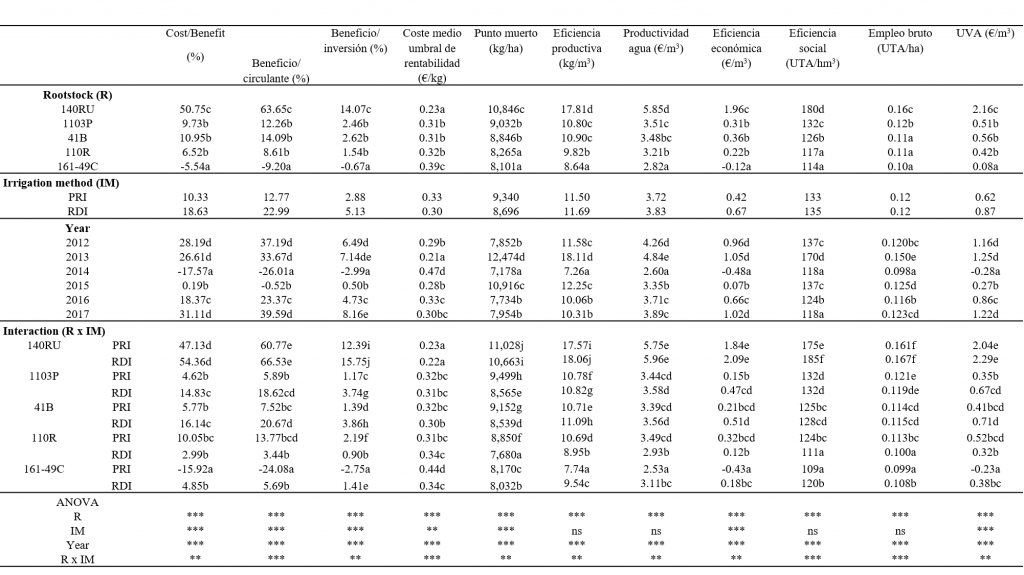Pascual Romero Azorín and José García García
In many areas of southern Europe, the scarcity of water due to climate change will increase, making its availability for irrigation an even more limiting factor for agriculture. One of the main necessary measures of adaptation of the vineyards in these areas will be the irrigation and the implementation of water-saving irrigation strategies and technologies to save water and to improve WUE (water use efficiency). The objective of the present study was to evaluate the long-term economic viability/profitability of different deficit irrigation techniques such as regulated deficit irrigation (RDI) and partial root-zone irrigation (PRI) with low water volume/fertilizer applied in a Monastrell vineyard in Southeastern of Spain to plants grafted on different rootstocks and to assess the productive, social and economic efficiency in these semiarid conditions. Through a cost/benefit analysis, socioeconomic and environmental criteria for the selection of optimal deficit irrigation strategies and tolerant/water use efficient rootstocks for the vineyards in arid environments are proposed.
The grapevines (Vitis vinifera L., var. Monastrell, syn. Mourvedre, a local red wine variety) were 20+ years old and were grafted on five different comercial rootstocks, each with a different vigor and drought tolerance: 140Ru, 1103P, 41B, 161-49C and 110R (Figure 1). Each rootstock was drip irrigated for six consecutive years (2012 -2017) using two different deficit irrigation techniques: Regulated Deficit Irrigation (RDI) and Partial Root zone drying Irrigation (PRI). All combinations were irrigated with similar annual water volumes and application of the same designed deficit irrigation strategy (Table 1).

Figura 1. Experimental vineyard in Cehegín, Murcia, SE Spain.

The economic and efficiency indices such as Net margin/Total cost (MN/C) (%), Net margin/operating cost (NM/c) (%), NM/investment (NM/K) (%), break-even point (kg ha−1), WUE (kg m−3), water productivity (€ m−3), and economic efficiency (€ m−3) were significantly higher in 140Ru compared to the other rootstocks, and the lowest (negative values for NM/C,NM/c, NM/K, and economic efficiency; not viable economically) for 161-49C, while other rootstocks showed intermediate positive values of these economic/efficiency indexes (Table 2). In relation to the social importance of the crop, the results indicate that the most vigorous and productive rootstock (140Ru) generated more employment (0.16 UTA/ha) and social efficiency (AWU hm−3) and had a significantly higher WVT (water viability threshold) (2.16 € m−3) (water price in which income and costs are equal) compared to the other rootstocks, due to an increased labor requirement and cost of pruning and harvesting. In contrast, less productive rootstocks (16149C and 110R) generated less employment and significantly lower social efficiency and WVT (Table 2).

ns’ not significant; *, **, and *** indicate significant differences at the 0.05, 0.01, and 0.001 levels of probability, respectively. In each column and for each factor, different letters indicate significant differences according to Duncan’s multiple range test at the 95% confidence level.
Our analysis also shows a clear conflict between productivity and quality in wine grape production. Productive and economic indices, such as yield, productive WUE (kg m−3), economic efficiency (€ m−3), break-even point (kg ha−1), and water productivity (€m−3), were inversely related with berry quality. Besides, the relationships between WUEyield, production costs, and QIoverall berry indicate that in the current wine market conditions, maximum productive efficiency is closely related to low productive costs and QIoverall berry (Figure 5). In contrast, maximum berry quality is closely related to lower WUEyield and higher production costs (Figure 5).

The analysis shows that in the very high WUEyield range, between 10 and 25 kg m−3, production costs are quite low, even below the current average price, due to very high productivity, making this option very profitable economically overall in high vigor and productive rootstocks such as 140Ru. In contrast, with lower WUEyield, (between 5−10 kg m−3), production costs start to increase sharply in an exponential way, whilst also increasing progressively the berry quality in a linear way (Figure 5). Below 5–6 kg m−3, production costs increase a lot, with little effect on berry quality. In these conditions, the rapid increase in production costs due to very low productivity makes this option economically unfeasible. In this situation, it will be difficult to implement optimized deficit irrigation strategies and a sustainable irrigation water use, and the pressure on water resources will increase in semiarid areas. According to this analysis, maximum QIoverall berry (≥12) was reached at a WUEyield of around 7.3 Kg m−3 (161-49C), which supposes a low yield, around 7256 kg ha−1 year−1, similar to the yield range obtained with 161-49C PRI, and within the yield range allowed by O.D. Bullas. Unfortunately, with the current low grape price in this area (0.326 € kg−1), this maximum quality option is unfeasible economically. In this situation, everything that supposes a production cost higher than the current grape price is not viable economically. According to our results, this corresponds with a WUEyield < 9 kg m−3 and a yield < 8128 kg ha−1. Thus, to maintain low production costs and high berry quality, the analysis aims for yield ranges between 8100 and 9000 kg ha-1, thus not exceeding the range allowed for D.O. Bullas wines (yield range 7500–9000 kg ha−1), and WUEyield between 9 and 10 kg m−3), which, with the current price of the grapes, could be a good compromise between productivity, quality, and returns for the growers.
Public policies should encourage vine growers to invest in producing high-quality local variety grapes as a differentiating character, as well as to develop agronomic practices that are environmentally and socially sustainable, by the grapes more adjusted to their real quality and production costs. Only in this way we can implement agronomic measures such as optimized low-input DI (deficit irrigation) techniques and the use of efficient rootstocks to improve WUE and grape quality in semiarid regions in a context of climate change and water-limiting conditions.

Pascoal Romero 
José García
Pascual Romero, Biologist, PhD. Agrarian researcher at the Instituto Murciano de Investigación y Desarrollo Agrario y Alimentario (IMIDA), Ministry of Water and Agriculture, Region of Murcia, Spain. Main head of several national search projects focused in topics related to the physiology of water stress, plant-soil water relations, water use efficiency and the application of different deficit irrigation techniques and new irrigation technologies in different species such as: almond, peach, citrus and vine.
Agronomist, PhD. José García García is researcher in Agricultural Economics at the IMIDA (Instituto Murciano de Investigación y Desarrollo Agrario y Alimentario), mainly specialized in economic and financial analysis and applied econometrics, and structural analysis of the agrifood sector. He works as a researcher at the IMIDA as coordinating researcher of the Bioeconomy team.He has participated in over thirty five research projects and contracts (some of them are European projects –LIFE, MED-). He has 50 published articles, 4 book chapters, 4 entire workbook and 35 communications to meetings. He has acted as reviewer for the following scientific journals: Industrial crops and products, Open Journal of accounting, British Journal of Applied Science & Technology, Asian Journal of Agricultural Extension, Economics & Sociology, Archivos de zootecnia, Veterenary annals.

